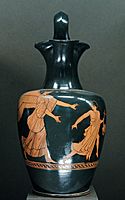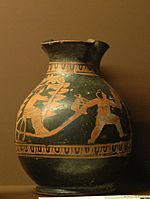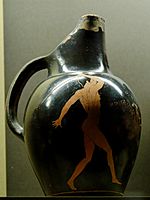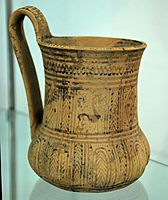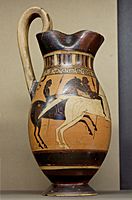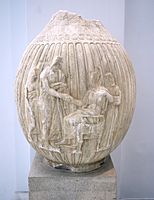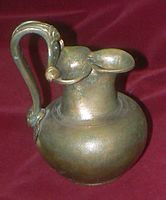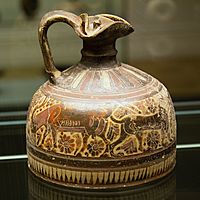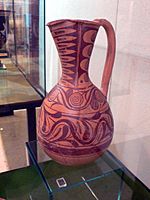Oenochoe facts for kids
Quick facts for kids Oenochoe |
|
|---|---|
| οἰνοχόη | |

|
|
 |
|
| Material | Mainly terracotta, rarely metals, stone, and later glass |
| Size | Typically 25 centimetres (9.8 in) or less in height |
| Writing | None in the Bronze Age, illustration names of depicted scenes in classical times |
| Classification | oenochoe, "wine pourer" |
| Culture | Cross-cultural in Mediterranean civilizations |
An oenochoe (say: ee-NOH-koh-ee) is a type of ancient Greek pottery that looks like a jug. Its name comes from two Greek words: oînos meaning "wine" and khéō meaning "I pour." So, an oenochoe is basically a "wine-pourer."
These jugs were very important in ancient Greece. They were used to hold liquids, especially wine, before pouring them into individual cups. Think of it like a pitcher you might use today. Oenochoes were popular during the Bronze Age, especially in places like ancient Troy. Over time, the word "oenochoe" became more about the shape of the jug than just what it held. So, an oenochoe could pour any liquid, not just wine!
Contents
Different Types of Oenochoe Jugs
There were many different shapes and styles of oenochoes. A famous expert named Sir John Beazley identified ten main types.
- The olpe (say: OL-pay) was an early type. It had a smooth shape with no clear shoulder, and its handle often rose above the rim.
- Another type, called the "type 8 oenochoe," looked more like a modern mug. It didn't have a specific pouring spout.
- The chous (say: KHOOS) was a short, round jug with a special three-lobed (trefoil) mouth. Small choes decorated with scenes of children were sometimes placed in children's graves.
What Makes an Oenochoe Special?
Oenochoes could be plain or beautifully decorated. Most of them had only one handle. Often, this handle was opposite a unique "trefoil" mouth. This mouth had three pouring points, which made it easy to pour liquids from different sides of a crowded table.
Their size varied a lot. Most were about 25 centimeters (10 inches) tall, easy to hold and pour with one hand. However, some much larger ones also existed.
Materials Used for Oenochoes
Most Greek oenochoes were made from terracotta, which is a type of baked clay. But some wealthy people owned oenochoes made from valuable metals like bronze. Very few of these metal jugs have survived today. Large oenochoes made of stone were sometimes used as grave markers, often carved with pictures.
Some pottery oenochoes were "plastic," meaning their bodies were shaped like sculptures, often human heads.
How Oenochoes Were Decorated
Early oenochoes from prehistoric times were made by hand, without much decoration. Simpler ones stayed that way. But over time, people started adding patterns like zig-zags and spirals. They also made surfaces smooth and shiny.
Later, during the Late Bronze Age, these patterns were painted to make them stand out more. From then on, Greek oenochoes followed the same artistic trends as other Greek pottery. Many amazing, high-quality oenochoes have been found and are now considered masterpieces.
Gallery of Oenochoe Jugs
-
An Olpe jug with riders, from Corinth, around 575–550 BC.
-
A Bronze oenochoe from Nova Zagora, Bulgaria, with a trefoil spout.
-
An oinochoe from the Archaic period, 750–600 BC.
-
An Apulian red-figure oinochoe by the White Saccos Workshop.
See also
 In Spanish: Enócoe para niños
In Spanish: Enócoe para niños


